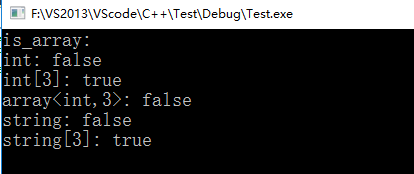- 1appium测试ios应用遇到的问题_appium测试ios如何过去sessionid
- 2easyexcel与vue配合下载excel
- 3HTML圣诞节代码,圣诞节贺卡源代码,实现圣诞节雪花飘落效果_圣诞节雪花html
- 4中文核心论文实战:基于通道注意力cbam+lstm的工业用电功率预测时间序列_基于cbam通道注意力的工业用电量预测
- 5鸿蒙(HarmonyOS)项目方舟框架(ArkUI)之Swiper容器组件
- 6《安富莱嵌入式周报》第301期:ThreadX老大离开微软推出PX5 RTOS第5代系统,支持回流焊的自焊接PCB板设计,单色屏实现多级灰度播放视频效果_william e. lamie
- 7打造纯Lua组件化开发模式:Unity xLua框架详解_unity lua框架
- 8安全可信 | 天翼云算力调度平台通过信通院首批可信算力云服务评估!_算力调度中的转发安全
- 9GAN人脸修复--Generative Face Completion_使用celeba数据集进行基于gan的人脸图像修复
- 10Unity VisionOS开发流程
type_traits
赞
踩
概述
type_traits提供了丰富的编译期间计算、查询、判断、转换和选择的帮助类,其被定义在#include <type_traits>下。
作用:
- 增强了泛型编程能力;
- 增强程序的弹性,使得在编译期间就可以做到优化、改进甚至排错,提高代码质量;
- 它所提供的选择功能一定程度上可以消除冗长的if-else或switch-case语句,降低程序的圈复杂度,提高代码的可维护性;
- 它所提供的判断功能,在编译期间可以检查出是否是正确的类型,以便能编写更为安全的代码。
- Helper Class
作用: 帮助创建编译时常量的标准类。
在C++11之前我们定义编译期常量的方法:
1. 通过定义静态变量,并通过CompileTimeContents::value方式获取该常量。
- template<typename Type>
- struct CompileTimeContents{
- static const int value = 1;
- };
2. 通过定义枚举变量方式。
- template<typename Type>
- struct CompileTimeContents{
- enum {value = 1};
- };
但在C++11中可以通过std::integral_constant 模版类派生:
- template<typename Type>
- struct CompileTimeContents :std::integral_constant<int, 1>
- {
- };
通过CompileTimeContents<type_name>::value方式获取该常量,这种写法好处是不用再定义额外变量,使用起来更加方便。
在标准库中的定义:
- template <class T, T v>
- struct integral_constant {
- static constexpr T value = v;
- typedef T value_type;
- typedef integral_constant<T,v> type;
- constexpr operator T() { return v; }
- };
- 判断类型
在traits中判断类型的模板类 都 继承自 std::integral_constant。
1. 判断目标类型是否为期望类型。
traits判断类型(下表展示部分,其他可到 http://www.cplusplus.com/reference/type_traits/ 查看):
| traits类型 | 说明 |
| 判断是否为数组类型 | |
| 判断是否为类类型而不是union类型 | |
| 判断是否为函数类型 | |
| 判断是否为引用类型 | |
| 判断是否为POD(传统Cstruct类型) | |
| 判断是否为内置类型 |
使用实例:
- // is_array example
- #include <iostream>
- #include <array>
- #include <string>
- #include <type_traits>
-
- int main() {
- std::cout << std::boolalpha;
- std::cout << "is_array:" << std::endl;
- std::cout << "int: " << std::is_array<int>::value << std::endl;
- std::cout << "int[3]: " << std::is_array<int[3]>::value << std::endl;
- std::cout << "array<int,3>: " << std::is_array<std::array<int,3>>::value << std::endl;
- std::cout << "string: " << std::is_array<std::string>::value << std::endl;
- std::cout << "string[3]: " << std::is_array<std::string[3]>::value << std::endl;
- return 0;
- }

运行结果:

判断类型通常会与std::enable_if结合使用,通过SFINAE(替换非错误)特性来实现功能更强的重载。
2. 判断两个模板类型之间的关系。
| traits类型 | 说明 |
| is_same | 判断两个类是否相同 |
| is_base_of | 判断Base类型是否为Derivedl 类型的基类 |
| is_convertible | 判断前面模板参数类型能否转换为后面模板参数类型 |
具体用法在官网依然有示例:
- // is_base_of example
- #include <iostream>
- #include <type_traits>
-
- struct A {};
- struct B : A {};
-
- int main() {
- std::cout << std::boolalpha;
- std::cout << "is_base_of:" << std::endl;
- std::cout << "int, int: " << std::is_base_of<int,int>::value << std::endl;
- std::cout << "A, A: " << std::is_base_of<A,A>::value << std::endl;
- std::cout << "A, B: " << std::is_base_of<A,B>::value << std::endl;
- std::cout << "A, const B: " << std::is_base_of<A,const B>::value << std::endl;
- std::cout << "A&, B&: " << std::is_base_of<A&,B&>::value << std::endl;
- std::cout << "B, A: " << std::is_base_of<B,A>::value << std::endl;
- return 0;
- }

运行结果:

- 类型转换
traits中给出了对参数属性的修改接口,如:其cv属性额添加或移除、引用的添加或移除、数组维度的修改等。
| traits类型 | 说明 |
| remove_cv | 移除cv属性 |
| add_cv | 添加cv属性 |
| remove_reference | 移除引用 |
| add_lvaue_reference | 添加左值引用 |
| remove_extent | 移除数组顶层维度 |
示例:
- // remove_cv example
- #include <iostream>
- #include <type_traits>
-
- int main() {
- typedef const volatile char cvchar;
- std::remove_cv<cvchar>::type a; // char a
- std::remove_cv<char* const>::type b; // char* b
- std::remove_cv<const char*>::type c; // const char* c (no changes)
-
- if (std::is_const<decltype(a)>::value)
- std::cout << "type of a is const" << std::endl;
- else
- std::cout << "type of a is not const" << std::endl;
-
- if (std::is_volatile<decltype(a)>::value)
- std::cout << "type of a is volatile" << std::endl;
- else
- std::cout << "type of a is not volatile" << std::endl;
-
- return 0;
- }

运行结果:

-
根据条件选择traits
std::conditional 在编译期间根据判断式选择两个类型中的一个,类似于常用的条件表达式。
template <bool Cond, class T, class F> struct conditional;当条件为真返回T类型,条件为假返回F类型。
例如:比较long long类型与long double 返回较大的类型
- #include <iostream>
- #include <typeinfo>
- #include <type_traits>
-
- int main() {
- typedef std::conditional<(sizeof(long long) > sizeof(long double)), \
- long long, long double > ::type max_size_t;
- std::cout << typeid(max_size_t).name() << std::endl;
-
- return 0;
- }
运行结果:

- 可调用对象返回值类型
通常我们获取函数返回值的类型使用的是decltype方式:
- template<typename T, typename Arg>
- auto Func(T a, Arg arg)->decltype(f(arg))
- {
- return f(arg);
- }
但是在某个类型没有模板参数时,就不能通过decltype来获取类型
- #include <iostream>
- #include <type_traits>
-
- class A{
- A() = delete;
-
- public:
- int operator()(int i){
- return i;
- }
- };
-
- int main() {
- // decltype(A()(0)) i = 4;
- decltype(std::declval<A>()(std::declval<int>())) i = 4;
-
- std::cout << typeid(decltype(std::declval<A>()(std::declval<int>()))).name() << std::endl;
- std::cout << i << std::endl;
-
- return 0;
- }

当用仅用decltype方式获取类型时,由于A没有默认构造函数,代码出错。
之后采用declval方式,通过 declval<A>() 获取任意类型的临时值,但临时值不能用于求值,需要借助decltype对临时值进行类型推导,得出最终返回值。
在traits中提供了另一解决途径:std::result_of
std::result_of<A(int)>::type i = 4;
函数原型:
- // 第一个模板参数为可调用对象类型,第二个模板参数为参数类型
- template <class Fn, class... ArgTypes>
- struct result_of<Fn(ArgTypes...)>;
- 根据条件禁用或启用某些类型
编译器在匹配重载函数时,通常匹配所有的重载函数,匹配一个如果失败了,编译器不会报错,而是接着匹配其他重载函数,选择最精确的一个去执行,整个过程不会报错(SFINAE)。
tratis中std::enable_if 根据限定条件选择重载函数,只对满足条件的函数有效。可作用于返回值、模板定义、类模板特化、参数类型限定。
函数原型:
- template <bool Cond, class T = void>
- struct enable_if;
用法示例:
- #include <iostream>
- #include <type_traits>
-
- // 1. 对函数返回值限定,只有模板参数T是integral类型时,才执行此函数
- template <class T>
- typename std::enable_if<std::is_integral<T>::value, bool>::type
- is_odd(T i) { return bool(i % 2); }
-
-
- // 2. 对模板参数限定,模板特化时,模板参数只能是intergal类型
- template < class T,
- class = typename std::enable_if<std::is_integral<T>::value>::type>
- bool is_even(T i) { return !bool(i % 2); }
-
-
- int main() {
-
- short int i = 1; // code does not compile if type of i is not integral
-
- std::cout << std::boolalpha;
- std::cout << "i is odd: " << is_odd(i) << std::endl;
- std::cout << "i is even: " << is_even(i) << std::endl;
-
- return 0;
- }

且通过编译期检查输入模板参数是否有效,来提前显示编译错误,避免运行时才被发现。


